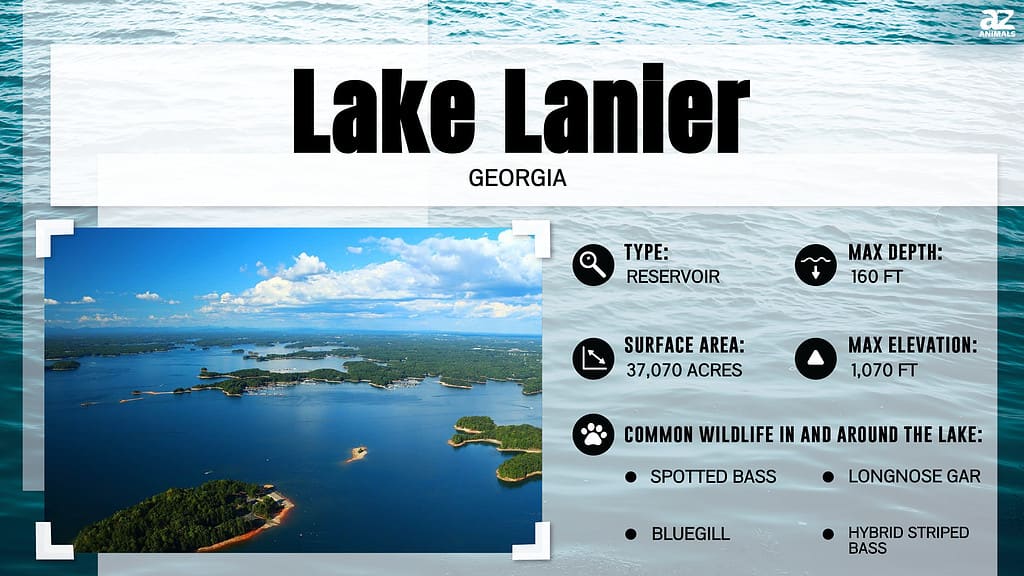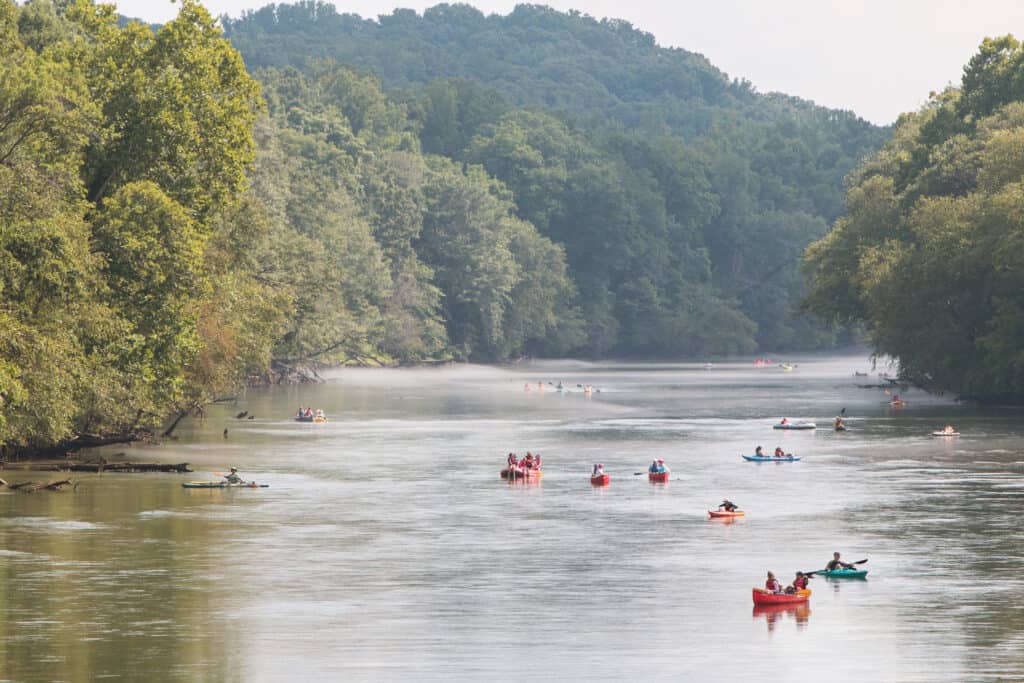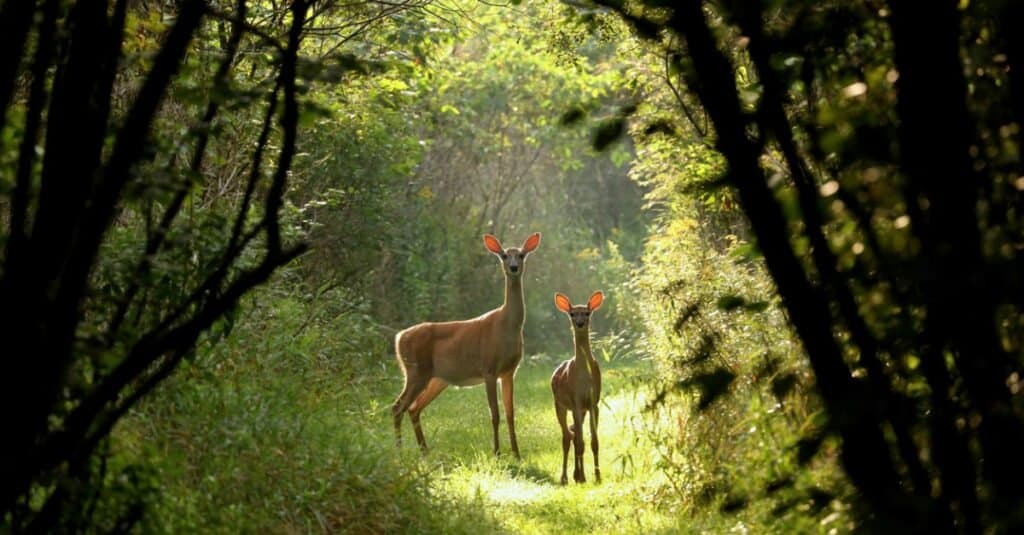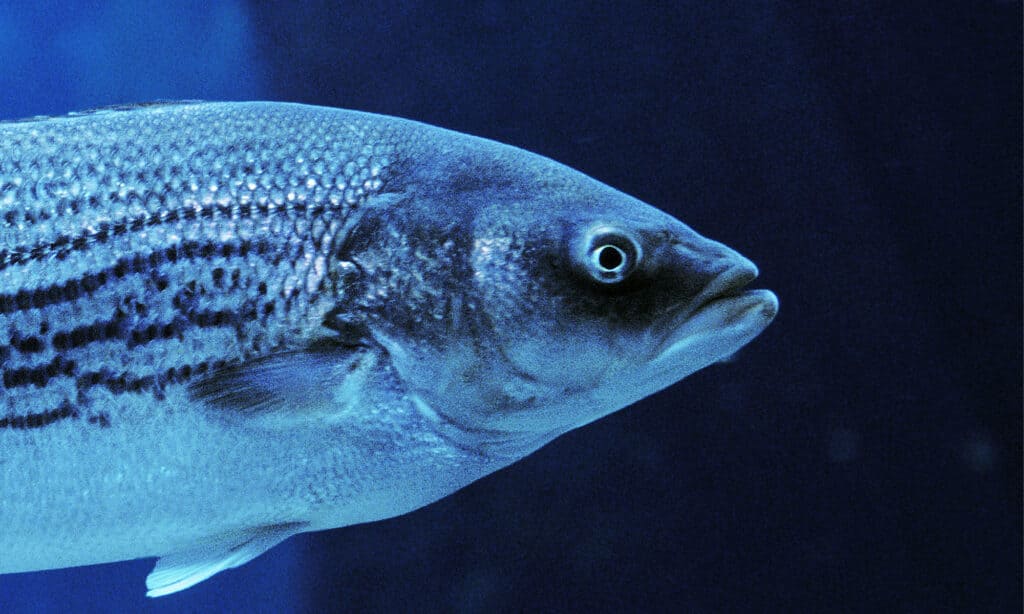
Lake Lanier is a favorite destination for boaters and fishers, as it is home to various fish species. The lake also provides hydroelectric power to surrounding areas. As such, it is an essential resource for recreation and electricity generation. But before going into too much detail, let’s explore how deep Lake Lanier is and what else makes it so appealing.
How Deep Is Lake Lanier?
Lake Lanier is quite deep, with an average depth of 156 feet. When full, the water surface is 1,071 feet above sea level. Consequently, Lake Lanier is a large reservoir covering an average of 59 square miles and 692 miles of shore.
What Are The Origins Of Lake Lanier?

Lake Lanier is an artificial lake in northeast Georgia in the United States.
©iStock.com/Steve Samples
Lake Lanier is an artificial lake in northeast Georgia, United States. It was created in the 1950s by the U.S. Army Corps of Engineers for flood control, power generation, and recreation. It is now the primary source of water for Gwinnett County, Georgia. The lake takes its name from Sidney Lanier, a Georgia poet and musician. Additionally, it is a popular recreation destination, providing activities such as swimming, boating, fishing, camping, and hiking.
Which Is The Deepest Part Of Lake Lanier?
Buford Dam is the deepest part of Lake Lanier, with a depth of more than 160 feet. The dam is on the Chattahoochee River in Georgia and provides hydroelectric power and flood control to the surrounding areas. In recent years, the lake has become increasingly shallow. This condition is due to evaporation and drought, but it remains an integral part of Georgia’s ecology.
The record low level of Lake Lanier occurred in December 2007 when the lake fell to 1050.79 ft. This figure is approximately 20 feet below its maximum level. However, it had a record high in April 1964, when the lake reached an elevation of 1077.2 ft. This elevation was about six feet above its top capacity level. Experts determined these levels for the records based on data from the U.S. Geological Survey.
Which Factors Affect The Water Levels Of Lake Lanier?
Fluctuations in the levels of Lake Lanier are common. These variations occur due to drought, heavy downpours, hydropower generation, flood control, and downstream fish and wildlife management. However, low water levels at Lake Lanier have many downsides. For example, they cause stress on businesses that depend on lake activity. Also, lower lakefront home values and more restrictions on how often people in Atlanta can water their lawns are typical outcomes of low levels.
The U.S. Army Corps of Engineers is responsible for managing the lake’s water levels. The Corps uses several methods to achieve this goal, including releasing water from the dam, operating the dam gates, and pumping water into the lake. In addition, the Corps monitors the lake levels closely and acts when necessary to prevent flooding or other damage. As a result of their efforts, the lake levels stay within a safe range, and fluctuations are relatively minor.
Which Rivers Flow In And Out Of Lake Lanier?

The Chattahoochee River is the primary inflowing river for Lake Lanier, and its primary outflowing river is the Chestatee.
©iStock.com/BluIz60
The primary inflow for the lake is the Chattahoochee River, with the Chestatee River being its main outflow. And the Chattahoochee River has a catchment area of 1,040 square miles, an average depth of three feet, and a maximum depth of six. It is home to various fish species, including bass, catfish, and trout. In addition, it provides drinking water for the city of Atlanta and surrounding areas.
Where Is Lake Lanier Located On A Map?
Lake Lanier is in the northern part of the state in the foothills of the Blue Ridge Mountains, near the towns of Gainesville, Buford, and Cumming. The lake is just 50 miles from the state capital, Atlanta.
Why Does Lake Lanier Have An Eerie History?
Georgia’s Lake Lanier was built after Congress authorized the construction of the Buford Dam on the Chattahoochee River in the 1950s. The resulting reservoir, which covers some 38,000 acres, is now the state’s most popular recreational spot. But few people know that the lake covers an entire town. Today, historians believe that some of the town’s unmarked graves and other structures still lie beneath the water.
In addition to its dark history, Lake Lanier has also been the site of dozens of swimming and boating accidents over the years. In 1994, for example, six students drowned while attending a party on the lake. And in 2010, a group of teens out celebrating graduation drowned after their boat capsized. As a result, more than 200 people have died in swimming and boating accidents on Lake Lanier since it was built, adding to its dark history.
What’s Underneath Lake Lanier?

Lake Lanier in Georgia was built over farming communities in the 1950s.
©http://www.terraprints.com / CC BY 2.5 – Original / License
The ruins of an old farm lie at the bottom of this lake, mostly in a decomposed state. The mortar that held these blocks together crumbled long ago. But, some remnants still protrude above water level, suggesting they were once part of something much bigger than just one building. Lake Lanier was created in 1956 at the same time as the construction of the Buford Dam. In the process of building it, the lake inundated several farms and small communities with water.
The resulting submerged structures are fascinating to divers. They can explore them and get a glimpse of life before the lake’s creation. And while some people may see these structures as eyesores, they’re an important part of the history of Lake Lanier.
Is It Safe To Swim In Lake Lanier?
Contrary to what its fascinating past may suggest, Lake Lanier provides a safe and enjoyable swimming experience. Unfortunately, this experience is unlike the Chattahoochee River. Although the lake is safe for swimming, the Chattahoochee River is unsafe for swimming and boating. This situation is due to constant rains in Georgia in 2021.
The lake has almost 700 miles of shoreline, with sandy beaches and private resorts providing swimming access. In addition, it has a water park that is perfect for families with young children who want to enjoy the outdoors. Essentially, Lake Lanier has safe swimming areas to suit most needs.
Animals Around Lake Lanier

White-tailed deer are among the animals living around Lake Lanier.
©iStock.com/Karel Bock
The forests around Lake Lanier are home to many species of animals that are native to Georgia. White-tailed deer are frequently sighted, along with red foxes, bobcats, river otters, raccoons, swamp rabbits, beavers, squirrels, muskrats and coyotes.
The area is home to over 240 species of bird species including many migrating songbirds, blue herrons, four species of hawks, bald eagles, osprey, several species of ducks, turkey vultures, Canada geese, gulls, snipe, indigo bunting. Lake Lanier is a bird watcher’s paradise! The National Park Service provides birders a complete list of birds that have been sighted.
There are around a dozen species of turtles around the lake and many native snakes. Frogs, toads and lizards live around the water, and several species of bats dart around in the night skies. There is no shortage of animals to see when visiting this beautiful recreational destination!
What Kind of Fish are in Lake Lanier?

Lake Lanier is popular for great striped bass fishing.
©iStock.com/slowmotiongli
Lake Lanier is home to diverse fish species, including striped bass, catfish, crappie, sunfish, walleye, perch, gar, and rainbow trout. In addition to being a prime place to fish, the lake offers beautiful scenery and picnic areas for those who want to enjoy a meal with a view.
The photo featured at the top of this post is © iStock.com/Steve Samples
Thank you for reading! Have some feedback for us? Contact the AZ Animals editorial team.







